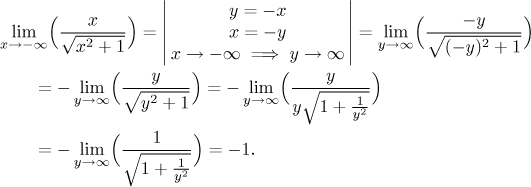Substitution rarely solves problems by itself, but it is used to simplify them and to move troubles from one place to another. The basic idea is as follows: We have an expression that is more complicated than we would like and we want to make it look simpler by taking a part of it and denoting it using some letter - a new variable.
We start with a very simple example: Find
![]()
Since the expression
![]()
Although it did not help substantially since the problem is essentially the same (so the methods to solve it would also be essentially the same), this new limit looks much easier and calculations will be most likely simpler.
Note that x disappeared from the problem entirely. That is one
of the basic rules of substitution. This includes the place under the "lim"
symbol, where we changed also the limit point. The new limit point was
obtained from the old one
Now we summarize how we do substitution.
Substitution:
Step 1. Decide which expression
Step 2. Use the basic substitution equality to "change the
variable", that is, replace all appearances of x in the limit by
appropriate formulas with y. In the expression in the limit we use the
basic substitution equality and equalities that can be derived from it. Under
the symbol "lim" we replace x with y and then change the limit
point, again using the basic substitution equality.
Notation:
![]()
Usually the new limit is of the same type as the original one, so substitution rarely gives an answer, but it can help in obtaining it. In particular, l'Hospital's rule requires differentiation and derivatives of simpler expressions are usually nicer. A nice example is this problem in Solved Problems. Sometimes this simplification can be so crucial that it makes a difference between being and not being able to solve the problem, see this problem in Solved Problems.
Sometimes substitution is not crucial but simply convenient. A trick I like is this. When evaluating expressions with powers and similar terms at infinity, we can use intuitive evaluation. We can also use it at negative infinity, but there it can be tricky.
Example:

It is easy to forget that the square root of x2 is

For more insight, see the general note on substitution.
Next box: polynomials at infinity
Back to Methods Survey
- Limits